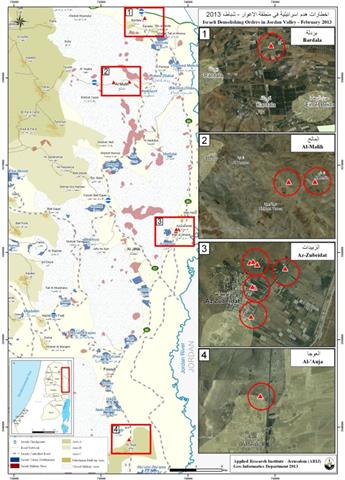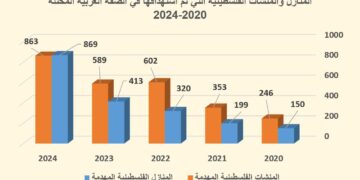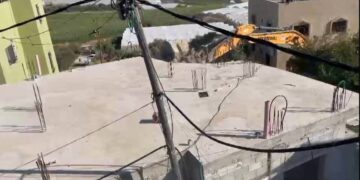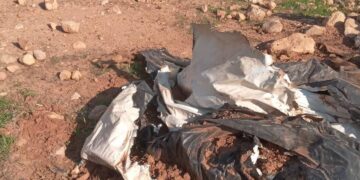Three demolition orders in Al-‘Auja Community North of Jericho
Table 1: Details of the targeted structures in Al-‘Auja North of Jericho | ||||
No. | Owner Name | No. of family members | Structure Type | Area (m2) |
1 | ‘Abed Rhayel Najada | 4 | Residential | 40 |
5 | Residential | 60 | ||
2 | Yasir Mahmoud ‘Ali Ka’abneh | 6 | Residential | 120 |
Total | 15 | ***** | 220 | |
Source: ARIJ field Workers- Al-‘Auja Municipality | ||||
Al-Zubeidat community Targeted with Nine Demolition Orders
Table 2: Details of the targeted structures in Al-Zubeidat Village | ||||
No. | Owners Name | Family Mbrs | Type of Structure | Area m2 |
1 | ‘Atef Salameh Salem Abu Dabbous | 7 | Residential house | 100 |
2 | Farouq Abdel Karim Mohammad Zubeidat | 10 | Residential House | 120 |
3 | Ahmad Ibrahim ‘Odeh Zubeidat | 7 | Agriculture Barracks | 30 |
4 | Karim ‘Odeh Youseph Al-‘Aryan | 8 | House + Barracks | 500 |
5 | Ibrahim Salim Salameh Zubeidat | 9 | Agriculture Barracks | 60 |
6 | Mohammad Ahmad Farhan Zubeidat | 7 | Agriculture Barracks | 40 |
7 | Salah Salameh Salem Abu Dabbous | 7 | Agriculture Barracks | 80 |
8 | Farhan Salman Mohammad Suleiman | 6 | Residential House | 120 |
9 | Ramez ‘Amer Al-F’oury | 11 | Playground | 400 |
Total | 72 | ***** | 1,450 | |
Source: ARIJ field Workers- Al-Zubeidat Village Council | ||||
Demolition Orders in Bardala in the Far north of the Jordan Valley
Table 3: Details of the threatened structures in Bardala- Tubas | ||
No. | Owners Name | Type of Structure |
1 | Jihad Saleh Sawafta | 10m3 Agriculture Water Pool |
2 | Ashraf Mustapha Ibrahim Sawafta | 10m3 Agriculture Water Pool |
3 | Fawwaz Ahmad Fayez Sawafta | 240 m2 Barracks |
Source: ARIJ field Workers | ||
Demolition Orders in Al-Malih East of Tubas
Table 4: Details for the Targeted structures in ‘Ein Al-Hilweh – Tubas | |||
No. | Owner Name | Family Mbrs | Type of Structure |
1 | Mohammad Rhaeil Suleiman Ka’bneh | 8 | Residential barracks |
Two animal sheds | |||
2 | Suleiman Rhaeil Suleiman Ka’bneh | 9 | Residential barracks |
Two animal sheds | |||
3 | Rhaeil Suleiman Ka’abneh | 11 | Two Residential barrackses |
Two animal sheds | |||
4 | Khader Ibrahim Ahmad Daraghmeh | 8 | Two Residential barrackses |
Two animal sheds | |||
5 | Nabil Mustapha Mohammad Daraghmeh | 10 | Two Residential barrackses |
Three animal sheds | |||
6 | Khalid Salem Ahmad Ka’abneh | 10 | Residential barracks |
Two animal sheds | |||
7 | Ahmad Rhaeil Suleiman Ka’abneh | 4 | Two Residential barrackses |
Two animal sheds | |||
8 | Fatimah Nassar Ka’abneh | 4 | Residential barracks |
Two animal sheds | |||
Total | 64 | 29 | |
Article 53 & 147 of the Fourth Geneva Convention of 1949 indicated that: Extensive destruction and appropriation of property not justified by military necessity and carried out unlawfully and wantonly, is a grave breach of the Convention.
Moreover Art. 23 of the Hague Convention of 1907 also provides: In addition to the prohibitions provided by special Conventions, it is especially forbidden to destroy or seize the enemy’s property, unless such destruction or seizure be imperatively demanded by the necessities of war.
Also under the Universal Declaration of Human Rights adopted and proclaimed by General Assembly resolution 217 A (III) of, December 10, 1948, Article 17 reads: ‘No one shall be arbitrarily deprived of his property.’ Which means it bans Israel from destroying or confiscating the property of the Palestinians at any case.
‘Article 12’ of the International Covenant on Civil and Political Rights Everyone lawfully within the territory of a State shall, within that territory, have the right to liberty of movement and freedom to choose his residence.
Article 13 of the Universal Declaration of Human Rights,: Everyone has the right to freedom of movement and residence within the borders of each State.
In the year 2004 the United Nations Security Council called on Israel to stop demolition of Palestinian homes under Resolution No. 1544-(2004), the resolution states: ‘The Security Council called on Israel to respect its obligations under international humanitarian law, particularly the obligation not to undertake home demolitions contrary to that law’.













